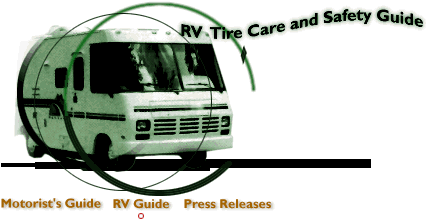|
|

The results of overloading can have serious consequences in terms of passenger safety. Too much weight for your vehicle's suspension system can cause spring, shock absorber or brake failure, handling or steering problems, irregular tire wear, tire failure or other damage. An overloaded vehicle is hard to drive and hard to stop. In cases of serious overloading, brakes can fail completely, particularly on steep hills. The load a tire will carry safely is a combination of the size of the tire, its load range and corresponding inflation pressure. Overloading your RV, with underinflated tires, can spell trouble.
Excessive loads and/or underinflation cause "tire overloading." As a result, abnormal tire flexing occurs, which can generate an excessive amount of heat within the tire. Excessive heat may exceed the tire's capabilities, which may lead to tire failure.
It is the air pressure which enables a tire to support the load, so proper inflation is critical. Since RVs can be configured and loaded in many different ways, air pressures must be determined from the actual loads (determined by weighing) and taken from the load and inflation tables provided by the tire manufacturer. These air pressures may differ from those found on the certification label. However, they should never exceed the tire limitation for load or air pressure.
If you discover that your tires cannot support the actual weights, lighten the load or install tires with a higher carrying capacity.
Note: Installing tires with a higher carrying capacity only solves the problem of tire overload. It has no effect on the overloading of other components (i.e., rims, axles, shocks, or bearings). Rims may not be capable of withstanding the higher pressures necessary to support the load.
If the load cannot be adequately reduced, contact the RV manufacturer for advice.
If you decide to install a tire size other than that originally provided on the vehicle, care must be taken to ensure adequate load-carrying capacity and compatibility between the tire and rim.
 |
WARNING!
There is a danger of serious injury or death if a tire of one bead diameter is installed on a rim or wheel of a different rim diameter. Always replace a tire with another tire of exactly the same bead diameter designation and suffix letters. For example: A 16" tire goes on a 16" rim. Never mount a 16" tire on a 16.5" rim. A 16.5" tire goes on a 16.5" rim. Never mount a 16.5" tire on a 16" rim.
While it is possible to pass a 16" diameter tire over the lip of flanges of a 16.5" size rim, it cannot be inflated enough to position itself against the rim flange. If an attempt is made to seat the tire bead by inflating, the tire bead will break with explosive force and could cause serious injury or death.

|
If you have operated your vehicle with an underinflated tire, promptly have it removed from the wheel for a complete internal inspection to be sure it is not damaged. Tires driven even short distances while underinflated may be damaged beyond repair.
Tires should be inspected regularly for excessive or irregular treadwear, bulges, aging, fabric breaks, cuts or other damages. Remove any nails, stones, glass, etc., embedded in the tread to prevent damage. Even minor damage can lead to tire failure. Replace tires when the tread is worn to 2/32" depth remaining in two or more adjacent grooves.

Built-in treadwear indicators, or "wear bars," which look like narrow strips of smooth rubber across the tread, will appear on the tire when that point of wear is reached. When you see these wear bars, the tire is worn out and it's time to replace it.
On vehicles with GVWR in excess of 10,000 pounds, federal regulations require that tires on the front axle be removed when worn down to 4/32" depth. It may also be desirable to replace tires prior to wearing down to 4/32" to improve traction or vehicle handling.
Load and cold inflation pressure imposed on a rim/wheel must not exceed the rim/wheel manufacturer's recommendation, even though the tire may be marked for a higher load and inflation.
Matching radial tires with rim/wheels must be done with extreme care. Not all older rims/wheels are approved for use with radial tires. Consult the rim/wheel manufacturer or local distributor or your tire dealer, to determine which rims/wheels are acceptable for use with a specific radial tire.
If your tires show uneven wear, ask a serviceperson to check for and correct any misalignment, imbalance, or other mechanical problem involved.
Tires will wear out faster when subjected to high speeds as well as hard cornering, rapid starts, sudden stops and frequent driving on surfaces which are in poor condition. Surfaces with holes and rocks or other objects can damage tires and cause wheel misalignment. When you drive on such surfaces, drive on them carefully and slowly. Before driving at normal or highway speeds, examine your tires for any damage, such as cuts or penetrations.
Check your tires frequently for scrapes, bulges, cuts, snags, or impact damage. Damage can occur to the inner portions of your tire without being visible on the outside. While driving, if you experience a sudden vibration or ride disturbance, or if you suspect that damage to your tires or vehicle has occurred, immediately reduce your speed or stop. Drive with caution or have your vehicle towed to the nearest vehicle or tire dealer to have your vehicle inspected.
| RV Tire Care & Safety Guide |
|

